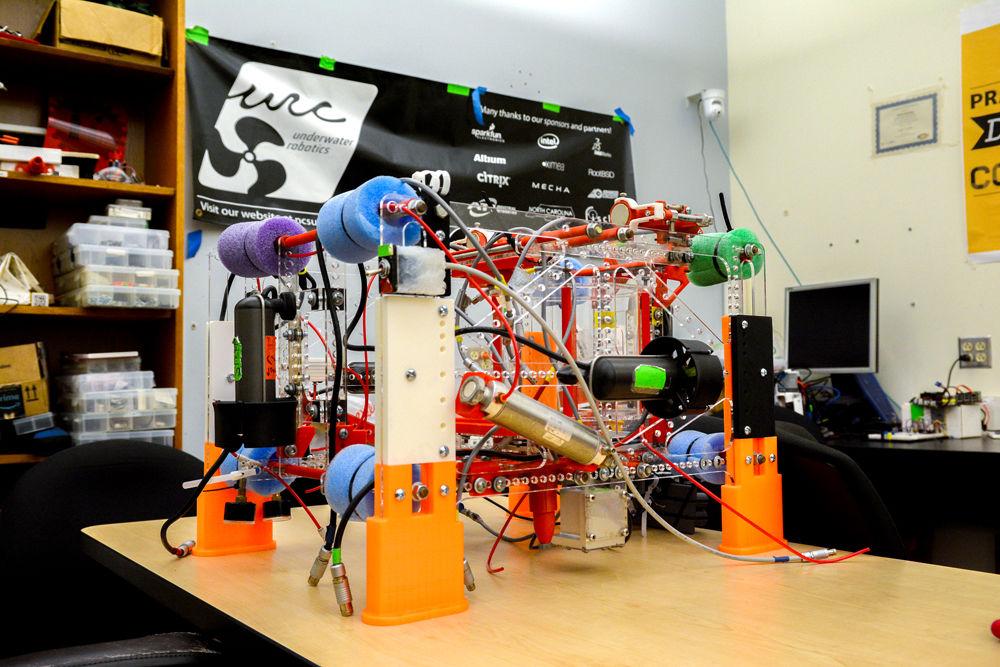In fictional versions of the future, the omnipresence of robots are an integral part of the science fiction genre. However, robotics is not only an idea of the far future. Teams across the world are working to construct new robots meant to fulfill an ever-widening set of tasks, including here at NC State. One team at NC State is taking their projects to new depths: underwater.
The Underwater Robotics Club is a group of NC State students who work together to build robots capable of operating in an aquatic environment.
Amalan Iyengar, a third-year studying computer science, is the club’s current president.
“The club was formed in 2004,” Iyengar said. “The first tests [for the robots] were done in the founding member’s apartment’s pool. We’ve grown a lot since then, we have our space in EB2 now, but the club has been active for fifteen years now.”
The club is comprised of four sub-groups, with each specializing in a different aspect of the project. These groups include the electrical, mechanical, software and acoustics teams.
“This is a pretty unique club, because everyone has to work within their sub-teams, and then the sub-teams all have to work together,” Iyengar said. “Our electrical sub-team doesn’t matter if it’s not in a waterproof hull that the mechanical team makes; without electronics, our mechanics don’t do anything, and without software our electronics are never told to do anything.”
Of these four groups, Iyengar works with the acoustics team.
“There are a bunch of beacons that [we put] in the water, and we have to make our robot listen to them, figure out which one to follow and follow it in an efficient way,” Iyengar said. “I’ll work on the circuits and the programming to make it follow those beacons.”
Though explanations of what the club’s robots are designed to do are somewhat simple, the process of creating a robot is another matter, and often has some bumps along the way. Jake Keller, a fifth-year studying electrical engineering and vice president of the club, is also the electrical team lead for the club. Keller spoke about how the group approaches problems in their projects.
“It depends on the problem,” Keller said. “A lot of times, it’s shutting everything off, making sure everything is good to go, then checking the easiest stuff first. There have been countless times where we’ve spent hours trying to fix, something and if we would have just taken two seconds to probe something with the multi-meter, we would have figured it out. So easy stuff first, then the most likely problem. Usually those two are intertwined, then going through a step-by-step process of ‘Hey, let’s try this; okay, that wasn’t the cause, keep going.”
Over the course of each year, the group focuses on building their robot with the intent to compete in the RoboSub international competition, held each summer in San Diego.
“There’s a lot of tasks within the competition,” Keller said. “Most of them are based around vision processing and a passive sonar-system, so that’s how we navigate and feel our way around. Then we’ll interact with obstacles by either bumping into them, driving through a gate, shooting torpedoes, dropping little bomb things, all sorts of different tasks.”
In these competitions, according to Keller, points are awarded based on these various tasks, with points being awarded for completion and attempts to solve obstacles, among other factors.
This year, the team is focusing on the critical systems of their robots to make sure everything is functioning optimally, with hopes of securing a top-15 finish in RoboSub’s competition by 2020, as mentioned by Iyengar.
“We spend all year doing it in some form or another,” Iyengar said. “we’re always improving, making repairs on the last one. In the summer, things typically kick into high gear, and we’ll get right down to it with our actual preparations for the nitty-gritty that have to happen, doing our final test runs and making sure everything is in order before it’s time to go [to compete].”
In preparing for their annual competition, the club’s members must often take what they have learned in their classes and apply it to the group’s current projects.
“It’s nice to have something to work on that’s technical but outside of a professor’s control,” Keller said. “We kind of have the guardrails off and have both the privilege and the pain of having to figure out things on our own.”
Keller also said that when working on projects with the club, a good amount of what they do extends past what they learn through coursework.
“A lot of what we do goes a lot further and beyond what we learn in the classroom,” Keller said. “It gives us a starting point, with a lot of the circuit stuff and designing the basic PCBs [printed circuit boards], but we tend to help new members go past what they’re learning in classes, kind of accelerate things a bit, but it lays the foundations for a lot of the things we do.”
Through both their competitions and advancement outside of their standard coursework, Iyengar said that the group has two main goals.
“What we’re trying to do from the leadership perspective is two things,” Iyengar said. “We’re trying to build a competitive robot that does well at the competition; we are a club that competes and a club that teaches our members. We teach our members how they can apply their technical skills that they learn in the classroom, to go beyond that disciplinary environment, and we teach them how to apply leadership skills and interpersonal skills to become the best functioning members of the industry and academia that they can be.”
For more information on the Underwater Robotics Club, the group can be contacted on their website.













